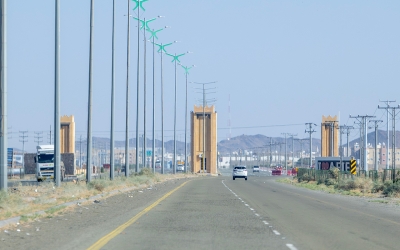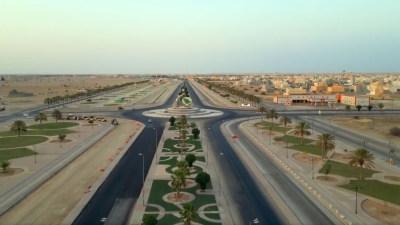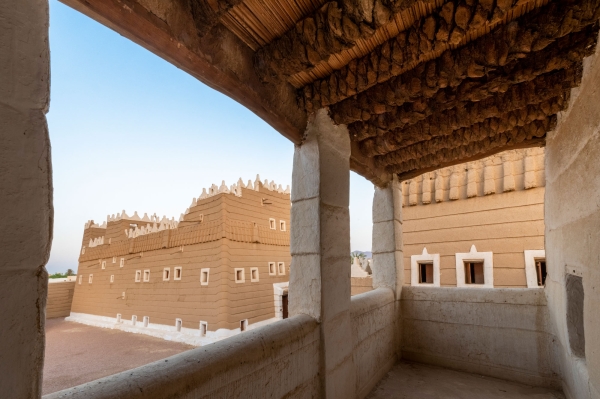
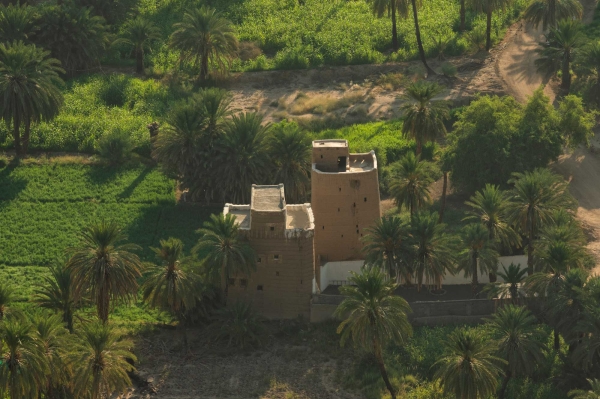
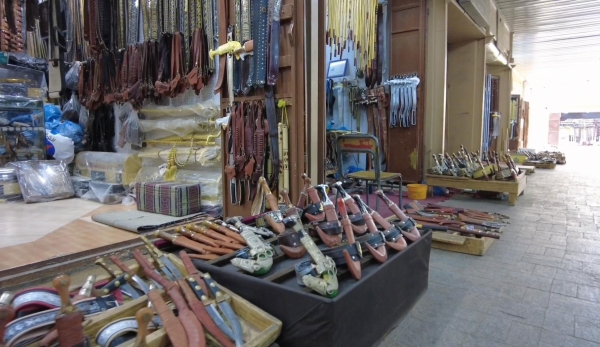
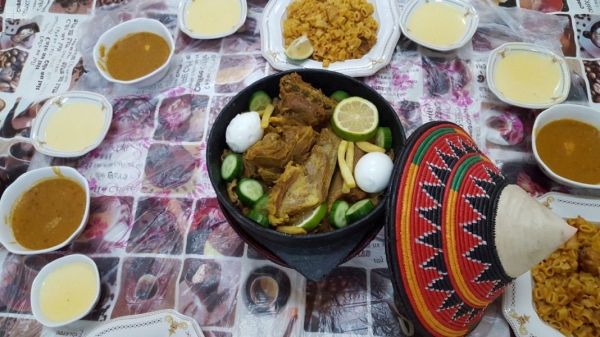
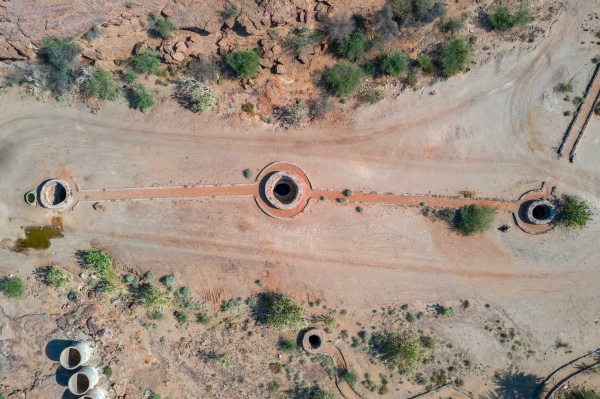
Najran City (Najrān) is the administrative capital of Najran Province, situated in the southwest of the Kingdom of Saudi Arabia. Approximately 71.2 percent of the province’s population resides there. Additionally, it hosts the majority of income-generating industries, encompassing agricultural production within Najran Province.
Designation of Najran City
The name Najran appears in many historical narratives and books by Arab and foreign travelers, with various naming narratives. One of these narratives suggests that Najran City was named after a person named Najran Bin Zaidan Bin Saba' Bin Yashjab Bin Ya’rab Bin Qahtan, who was the first resident of the city. Another narrative suggests that the name Najran originates from the wood on which the door rotates, with the name later being attributed to the city and its valley. Archaeological inscriptions found at al-Ukhdud archaeological site in Najran City show the name 'Najrn', referring to the old Najran and dating back to the beginning of the first millennium BC.
Najran City location
Najran City is situated in the southwest of the Kingdom, spanning longitudes 44 to 52 degrees east and latitudes 17 to 20 degrees north. It serves as the administrative capital of Najran Province, established in 1992, and is the seat of its emirate. Geographically and organizationally, it falls under the scope of Najran Province, alongside six governorates: Sharurah, Hubuna, Badr al-Janub, Yadamah, Thar, and Khibash, encompassing a total of 65 administrative centers.
Population of Najran City
The population of Najran City reached 421,902 people, according to the 2022 Saudi Census, with Saudis constituting approximately 66.7 percent of the city’s population, totaling about 271,719 individuals. The population of Najran Province stands at 592,300 people, with 71.2 percent residing in the administrative capital, Najran. The population growth rate in Najran Province reaches 2.26 percent annually. Spanning an area of 130,000 km, Najran occupies 6.6 percent of the total area of the Kingdom.
Economic activity in Najran City
Najran City serves as the administrative and economic hub of the province, boasting the majority of income-generating industries. Among these are agricultural production of vegetables, citrus fruits, and dates. Additionally, the trade, mining, and industrial sectors form fundamental pillars of the province's economy. To the northwest of the city lies the mine of al-Masane al-Kobra Mining Co., estimated to produce around 4.9 million t of copper, zinc, gold, and silver annually. Moreover, the trade sector plays a leading role in contributing to the gross domestic product (GDP) of Najran Province, accounting for 24.4 percent of its total GDP.
Climate of Najran City
The climate in Najran varies depending on the terrain. It is generally hot in summer and cold in winter, with rainfall in the highlands. Temperatures during the year range from fourteen to thirty-seven degrees Celsius, affected by northeastern winds during winter and summer and by eastern and southeastern winds during spring.
Sports clubs in Najran City
Najran City includes sports clubs, including Najran SC, founded in 1980, and al-Okhdood Club, founded in 1976.
Najran airport
It was established in 2011 and serves as the main airport for Najran Province, catering to Najran City and the governorates of the province. It is supported by Sharurah domestic airport.
The airport is located approximately twenty-six km northeast of the center of Najran City. It sits roughly thirty-five km away from al-Ukhdood archaeological city, a significant archeological site in Najran Province, and about fifty-seven km from al-Khadra border port, which marks the Kingdom’s international land border with the Republic of Yemen.
Operated by the General Authority of Civil Aviation, Najran Airport boasts a passenger capacity of 1.4 million travelers. It facilitated 5,858 domestic flights, serving 726,181 passengers throughout the year 2022.
Accessible directly via King Abdulaziz Road, the airport is reachable from inside the city within approximately thirty minutes.
According to the location of the Kingdom’s airports on the map and their distribution by the General Authority of Civil Aviation, Najran Airport is part of the southern group of airports. To its east lies Sharurah Airport, to its west is King Abdullah International Airport, and to its north are Abha and Bishah Airports.
Facilities at Najran Airport include a VIP lounge, arrival and departure lounges, airline offices, communication and banking services, as well as transportation services outside the lounges. Additionally, there are catering and advertising facilities, luggage packing services, car transportation and shipping services, and parking facilities.
During 2019, the General Authority of Civil Aviation undertook maintenance and operation projects at Najran Airport. These projects included the installation of electric generators, the procurement of transport vehicles for passengers’ luggage, and the renewal and signing of contracts for commercial services such as food, self-service devices, and tourism, travel, and banking activities.
Topography of Najran City
Although the Empty Quarter Desert intertwines with the central and eastern parts of Najran Province, the area is considered fertile for agriculture, serving as one of the largest sources of citrus crops in the Kingdom. In fact, 40 percent of its land is designated for agricultural use, and the Najran Valley, one of the largest valleys in the Kingdom, traverses the territory, dividing the administrative capital into northern and southern parts. Natural reserves cover 9.23 percent of its territory, with the highest elevation reaching 2,224 m above sea level east of Dhahran al-Janub.
Urban heritage in Najran City
The urban identity of Najran Province reflects scenes of a rich history, boasting thirty-four historical villages, ancient palaces and castles, along with heritage buildings such as clay paths and watchtowers constructed from clay. Wood and clay are the primary building materials in the ancient Najran City buildings. The construction process begins with laying the foundation, known as al-Wathar, comprised of clay mixed with stones, which is then affixed with al-Madamak, a brick-like material, and left to dry for a day or two. Subsequently, the construction is finalized, and the building is sealed using a technique called al-Samakh, involving plastering the roof constructed from wood, palm trunks, tamarisk, and sidr (ziziphus spina-christi) trees.
The archeological castles in Najran Province serve as visual icons, embodying the history and heritage of the province, particularly in relation to the traditional mud architecture of the Kingdom. The historic Amarah Palace is an ancient palace that reflects the traditional construction method of the province. Situated in the heart of the old city of Najran, this palace was erected in 1942 in the style of a fortress, featuring towering walls and circular watchtowers at each of its four corners. It is comprised of approximately sixty rooms and a mosque.
Among the archaeological palaces and castles are: Al-Aan Heritage Palace, located west of Najran City, which was built in 1689 and is still inhabited. Additionally, there are Ra’um Castle, al-Midhaar Kasbah, and al-Humdah region palace.
The archaeological site of al-Ukhdood is one of the visual icons that represent the ancient history of Najran Province. Situated between the villages of al-Qabil and al-Jariya on the southern bank of the Najran Valley, it encompasses the remnants of the ancient city of Najran, featuring numerous ruins such as houses and ancient graves.
One of the prominent sites in the province is the 'Hima Cultural Area', which was registered on the World Heritage List of the United Nations Educational, Scientific and Cultural Organization (UNESCO) as a cultural site of outstanding universal value for human heritage in 2021. Hima includes six wells, namely 'al-Hamata' and 'Saqya', as well as 'al-Jnah', 'Umm Nakhla', 'al-Qarayn', and 'al-Habisa'. Surrounded by caves and mountains, these wells are considered open-air museums of archaeological rock inscriptions.
The Hima site also contains tens of thousands of rock inscriptions written in several ancient scripts, including inscriptions in Thamudic, Nabataean, Southern Musnad, Syriac, and Greek, in addition to early Arabic inscriptions (from the pre-Islamic period), which are considered the beginnings of modern Arabic calligraphy. Among historic icons are Jabal ad-Dharwa, Alia Rock, the site of Shuaib Dahdah, and the site of Dam al-Madiq.
The Najran Dam stands as a prominent urban landmark in the province and serves as a key tourist attraction. It was inaugurated in 1982, boasting a storage capacity of eighty-six million m, with dimensions of 260 m in length and sixty m in height. Additionally, the public squares of Najran Province include several visual icons, constructed to impart aesthetic and artistic charm to these spaces and areas within Najran.
Traditional garments of Najran City
Traditional garments in Najran Province reflect the popular heritage and traditional attire of its inhabitants from past eras. Generally, these garments have become mainly renowned within the heritage context, serving as emblematic representations of heritage and cultural identity for the southern regions of the Kingdom in general, especially Najran Province.
Ancient men's garments reflect the customs of Najran society in terms of dress. The garments appear simple, attributed to the quality of the environment and lifestyle. Some individuals prioritize comfortable clothes that facilitate movement and walking.
Al-Muthayal garment is a thobe made from white fabric, featuring long and wide sleeves that extend to mid-leg. This popular attire has been passed down through generations, from grandparents and fathers to children, and continues to be worn on various occasions by the residents of the province.
Al-Gharru is also among the popular men's garments. It is a piece of cloth and strands of goat hair placed on the Ghutra, serving as both Aqal and Asabah.
The Najrani costume is typically complemented by wearing the Janbiya, belt, and Tayyar. The belt includes a variety known as 'Masbat' and is worn around the man's waist. The tayyar, resembling a belt, is worn over the shoulder. These accessories are considered ornamental and serve to enhance men's garments.
Najran women's fashions have varied in the past. Initially, they were crafted from simple materials, with embellishments and embroideries made from threads and ornaments adorning their attire. These fashions evolved into traditional styles. However, some older women continue to adhere to these garments, passing them down through generations.
The Mukamam garment is crafted from a long, black fabric with broad, elongated sleeves. Colored threads, such as red, embellish the fabric around the chest area. Traditionally, women from Najran wore a white garment beneath the black mukamam dress, which gradually turned black over time. However, nowadays, women forego this layer and opt to wear the black mukamam alone.
The woman places what is known as a rag or thread on her head. Upon this rag, she lays a circularly woven thread of hair, adorned with a collection of silver jewelry that drapes over her face.
Traditional markets of Najran City
The traditional markets in Najran City are generally known as open spaces surrounded by alleys inhabited by skilled craftsmen, such as leather tanners and carpenters, who prepare goods for sale on seasonal market days. Stalls are organized in traditional markets based on the type of goods transported, eventually evolving into commercial activities distributed across separate areas. Each area is designated with a name associated with its geographical location or social movement.
Najran City was known as an important center for craft markets, encompassing most of the leather craft industries, such as al-Mizab and al-Mashrab, second only to the Jambiya (dagger) industry. Additionally, Najran boasted palm wickerwork, al-Maharak, pottery, soapstone, and weaving industries.
There are approximately seven traditional craft markets in Najran Province, where craft activities span from leather, wicker, silk, and dagger manufacturing—important industries in the province—to traditional weaving and the manufacturing of traditional agricultural tools. Most of these traditional markets are recognized as heritage and economic centers simultaneously. They embody a cultural and economic significance that the Ministry of Tourism aims to develop. In 2012, the ministry initiated a program to enhance and revitalize the traditional markets in the Kingdom to ensure their sustainability and transform them into cultural, economic, and tourist destinations.
The traditional markets in Najran City feature two main architectural styles: al-Mastara and open space. Open-space commercial shops are arranged around a central courtyard, with a surrounding corridor where various cultural activities associated with the traditional markets take place. On the other hand, the Qaysariyya style is distinguished by a primary entrance alongside subsidiary entrances. The shops in this style can be interconnected on three sides, leaving the fourth side with an independent entrance to the market. In contrast, the open space type is characterized by its temporary nature, with buildings resembling individual stalls not interconnected, overlooking a central public square within the market.
The historic Aba al-Saud neighborhood is situated in the center of Najran City, a market renowned in the Kingdom for the trade, manufacturing, and maintenance of daggers. Al-Jambiya markets in Najran City can be considered among the most expensive, particularly in terms of the prices of some of the goods displayed there. The price of a locally made dagger varies according to its craftsmanship, quality, and age, often reaching around SAR100,000.
The traditional women's market in Najran stands out as one of the oldest and most renowned markets in the province, exclusively designated for women. It is a traditional market with an extended layout covered with zinc panels. This market operates daily and is especially renowned for trading popular women's products, belongings, and clothing.
The traditional market in Najran is one of the markets that are touristically linked to the province. It gained its importance from its proximity to the historic Amarah Palace. It is an extensive array of commercial shops covering an area of up to four thousand m.
Landmarks and monuments in Najran City
Monuments of al-Ukhdood City
Najran Province contains the monuments of al-Ukhdood City, whose owners' story was mentioned in the Quran, in addition to more than one hundred archaeological sites.
A pottery jar containing more than one thousand coins was found at al-Ukhdood site, along with metal seals and stones engraved with the southern Musnad script, dating back to the first century AD. The site also has a palace dating to 500 BC until the middle of the first millennium AD.
Hima Cultural Area
The historical archaeological sites include the 'Hima Cultural Area,' which was inscribed on the World Heritage List of the United Nations Educational, Scientific and Cultural Organization (UNESCO) in 2021. Situated north of Najran City, approximately 130 km away, it stands as one of the largest open-air museums for archaeological rock inscriptions, boasting numerous archaeological sites, inscriptions, and rock paintings. The area encompasses more than thirteen sites of rock paintings.
Aba al-Saud Historic Neighborhood
There are several archaeological neighborhoods in Najran Province, including the Aba al-Saud historic neighborhood. This area hosts numerous traditional and heritage markets, showcasing archaeological artifacts and crafts unique to Najran Province, such as daggers and Jambiya, alongside leather industries, textiles, and stone and pottery utensils. Additionally, the historic Amarah Palace stands as a distinctive landmark renowned for its exceptional construction and engineering planning.
Najran Museum of Heritage and Antiquities
The Najran Museum of Heritage and Antiquities is situated roughly seven km from al-Faisaliah neighborhood, at the heart of Najran City, within the northwestern perimeter of the archaeological site of al-Ukhdood. The museum building comprises several exhibition halls, totaling six, featuring highlights like the “Live Saudi” hall, alongside a designated hall for visual presentations. Additionally, there are two halls specifically allocated for hosting visiting performances and exhibitions, complemented by a library facility.
The province contains the site of al-Darib ruins, located east of the city of al-Ukhdood, four km away, and it includes some stone foundations dating back to the first century.
The province also contains al-Ajma ruins, comprising pottery remnants and ancient inscriptions located in the village of Dahdha. Located thirty-five km northeast of Najran, the Najran cemetery features tombs, irregular stone formations, and numerous archaeological inscriptions. The historical Ra’um Castle is situated atop Jabal Ra’um. Additionally, notable monuments include the al-Aan Palace, constructed in 1100, and al-Midhaar Kasbah, an ancient clay tower in Badr al-Janub Governorate
Traditional dishes in Najran City
Traditional dishes ingredients
Traditional dishes in Najran City are renowned for their predominant use of wheat-based ingredients. Najran whole wheat serves as a primary component in many of the city’s traditional dishes, forming the base for a variety of baked goods with distinct names reflecting their unique preparation and baking methods. Examples include al-Qan'oun, also known as al-Mujammar or Qors, al-Mardhufa, and Raqsh, which are served on numerous occasions.
Najran cuisine
Najran cuisine reflects the history of the province's popular heritage and handicraft arts. Raqsh stands out as the main dish on tables across Najran City or during public occasions, particularly in the month of Ramadan. It features whole wheat bread soaked in broth with meat. Accompanying Raqsh is al-Wafd dish, considered a side dish in Najran's culinary culture. Preparing al-Wafd begins with crumbling bread, followed by shaping it into circles before adding it to the broth. These dishes are served in Madhan and Matrah, which are locally made stoneware in the province.
Popular dishes in Najran Province are known for their simplicity, served in various methods in clay pots specifically designated for each dish. For instance, the hollow stone pot used for serving soup or broth is commonly referred to as 'al-Burma'. Cooked vegetables and meat are also typically served in a clay pot or a stone dish known as 'Maghsh'. These dishes are traditionally covered with 'Madhan', made from palm leaves.
Many traditional dishes in the province rely on whole wheat flour or millet, with at least one of these two being the foundation for preparing traditional dishes in the province. Generally, traditional foods in Najran are not considered fatty, except for Raqsh. Most dishes incorporate whole wheat flour, vegetables, and occasionally meat at festive tables.
Hamisa is popular in Najran City. It is a hearty dish consisting of meat and fat, which are finely diced and simmered in oil with constant stirring for about an hour. Mahshoush is typically served alongside rice or baked goods and can be stored. Despite the simplicity of its final form, preparing Hamisa requires precision in both cutting the meat and calculating the time needed for its cooking.
In the entertainment context, various festivals are held every year, including venues for productive families interested in selling traditional foods in Najran Province. Attendance varies between the National Festival of Culture and Heritage (Al-Janadriyah) in Najran Province's pavilion and festivals specific to the province, such as the We All Love Heritage Festival in the historic Amarah Palace. In the Aba al-Saud neighborhood, the pillars of productive families showcase their efforts in cooking traditional dishes and serving them in clay pots, reflecting the unique cultural heritage of each family.
Education in Najran City
First formal school
Formal education began in Najran Province with the opening of the first formal school, the Alamiriah School (now King Saud School). At the time of its establishment, the school enrolled 120 students.
The General Department of Education in Najran Province provides school transportation services for male and female students. The administration is also responsible for educational supervision, training and scholarships, school equipment and school health, tests and admission, special education, care for the gifted and talented, adult education, guidance and counseling, student activity, kindergartens, and others.
General education
The total number of general education schools in Najran Province across its three stages: primary, middle, and secondary, reached approximately 561 government schools. Among these, the total number of general education schools for girls was 297, while the total number of boys’ schools amounted to 264. Concurrently, the total number of general education students across these stages in Najran Province totaled about 140,341 male and female students. This was complemented by 9,192 male and female teachers. The female student population amounted to approximately 83,278, whereas the male student population was about 57,063. These statistics are sourced from an official census issued by the Ministry of Education, covering general education indicators from 2016 to 2023.
Private education
Najran Province comprises forty-eight private schools across its primary, middle, and secondary levels. Among them are twenty-six private schools catering to male students, with a total enrollment of 4,098, and twenty-two girls’ schools serving 2,009 female students. These schools employ a combined total of 567 male and female teachers. Notably, approximately 67 percent of students in private education are boys, whereas around 33 percent are girls.
University education
In Najran City, there is one government university, Najran University, which was founded in 2006. It comprises fourteen colleges with 45,000 male and female students, alongside a private institution, al-Ghad International College for Applied Medical Sciences.
Related quizzes
Related articles

